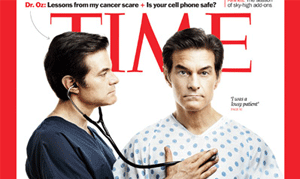Dr. Oz: A Different Side of the Famed Heart Surgeon
 Diana Cepeda takes the subway between her Brooklyn home and her Times Square office. Up until a year ago, it was a daily commute that could have killed her. "I was born with heart disease," she said. In and out of cardiologists' offices since she was eight years old, Cepeda's heart condition worsened last year. "As I got older, my aortic valve started deteriorating, and my mitral valve had a little pinhole in it," she said. When she was 53, her failing heart led her to New York-Presbyterian Hospital's Columbia campus to visit one of the best-known heart valve surgeons in the country -- Dr. Mehmet Oz, the celebrity doctor famous for his appearances on Oprah Winfrey's show and his own daytime talk show.
Diana Cepeda takes the subway between her Brooklyn home and her Times Square office. Up until a year ago, it was a daily commute that could have killed her. "I was born with heart disease," she said. In and out of cardiologists' offices since she was eight years old, Cepeda's heart condition worsened last year. "As I got older, my aortic valve started deteriorating, and my mitral valve had a little pinhole in it," she said. When she was 53, her failing heart led her to New York-Presbyterian Hospital's Columbia campus to visit one of the best-known heart valve surgeons in the country -- Dr. Mehmet Oz, the celebrity doctor famous for his appearances on Oprah Winfrey's show and his own daytime talk show. "When I sent all my films to his office I was just praying that I would get him," Cepeda said. "I really didn't want anyone else, just him, so I kept being a pain in the butt with his secretary."
When Cepeda eventually got an appointment with Dr. Oz, he told her she needed to have her aortic valve replaced soon.
"This is not a good way of fixing it," he told her. "This valve on you is stuck. It's like a door… the hinges aren't working so it doesn't open all the way, it doesn't close all the way."
Not only did Cepeda need surgery soon, but she had to quit smoking.
"I have never operated on a smoker," Oz said. "It is so disheartening to me to have someone actively hurting themselves when I'm trying to help them. It means they're not committed to the process."
Oz is much more than a face on TV. He is one of the most accomplished cardiac surgeons in the world.
"A lot of folks don't realize that I still practice medicine," he said.
Born in Cleveland to Turkish parents, Oz said he felt a natural attraction to medicine.
"There are very few things in life that I could have done successfully," Oz said. "Heart surgery is probably one of the few that I could have chosen. It demands immediate decision-making ability. It demands... courage to take changes because someone has got to make a decision."
Oz also admitted that approval from his father played a role in his decision to become a surgeon.
"My father came from a very poor family in central Anatolia in the Koran belt of Turkey," he said. "Came to this country without a single word of English, really, under his belt, educated himself, pulled himself up and became a surgeon. Deep down inside of me, there's a craving to show him, my father, that I'm worthy, that I'm a man."
Perhaps that is why surgery alone wasn't quite enough for Oz. While he recognized that he loved heart surgery, the doctor said he also wanted to explore other spaces.
"I love teaching but I also felt that my hands were tied often times because I could only do that one at a time in the hospital, one patient by one patient," Oz said. "I think my purpose in life was to talk to talk to people, whether it was in an operating room, a hospital suite, in the parking lot as they go home or on my television set, it's all the same."
Despite his success, both in the operating room and in the TV studio, Oz said he still views himself as a doctor first.
"I never thought of myself as a celebrity and I don't say that with false modesty," he said. "Surgeons are not modest people. We are all about controlled arrogance. We have to believe with our hearts that we can take you into an operating suite, take a band saw to your sternum, open it and still help you."
Before she headed into surgery, Cepeda said she was nervous, but felt very comfortable with Oz. Her family waited anxiously outside the operating room while she went under the knife.
During the surgery, Dr. Oz discovered something unexpected -- Cepeda's aortic valve only had two parts. Normal aortic valves have three parts. It's a defect with which she was born. (Source: Ben Newman, ABC)
Last modified onSaturday, 06 May 2017 10:07
Latest from Admin TOA
- Dünya Enerji Konseyi Avrupa Bölgesel Toplantısı İstanbul’da Gerçekleşti
- Retrial Ordered in Fraud Case Against Turkish-American Businessman Yalçın Ayaslı
- From a Bag Stand in Connecticut to a 40,000 Square Foot Warehouse in New Jersey: Ali Dayı's Entrepreneurial Journey
- Hiram & Solomon Cigars Introduces the Patriot Cigar Honoring M.W. George F. Hamilton, 91st Grand Master of Masons in Massachusetts
- PCA Officially Announces 2025 Trade Show Dates
